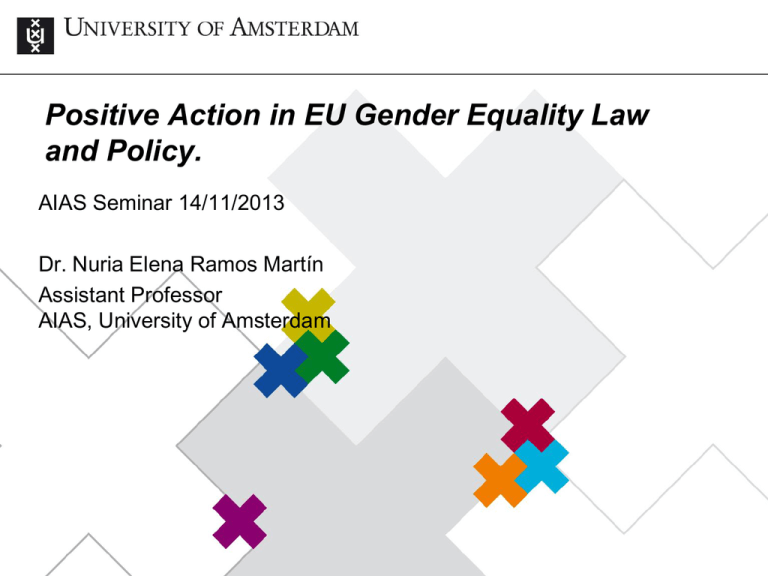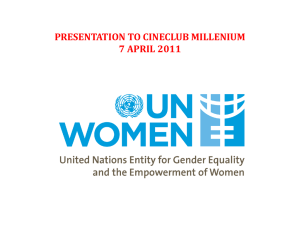
Positive Action in EU Gender Equality Law
and Policy.
AIAS Seminar 14/11/2013
Dr. Nuria Elena Ramos Martín
Assistant Professor
AIAS, University of Amsterdam
Aim
A.
B.
C.
D.
Analyze the concept of positive action
in EU law (Focus on measures in
favour of female workers)
Legal provisions
CJEU’s Case law interpreting the
relevant provisions
Implementation at Member States level
New EU proposal for a Directive:
Gender Quotas in company boards.
2
Debate on Positive Action
Proponents: Because of prior discrimination in
employment, women and minorities are handicapped
when they try to enter employment, obtain a promotion
or retain a job.
Positive action stricto sensu (preferred treatment
regarding entrance to jobs, promotion and retention of
employment ) = remedy for the effects of prior
discrimination.
Opponents: Why an individual must lose his chance of
entrance to a particular job and bear the burden of
redressing grievances made by the whole society?
Difficulties to set up the groups entitled to
preferential treatment.
Problems connected to the idea of preference: may
reinforce common negative stereotypes.
3
Positive action measures in EU law:
-
-
Several related concepts: affirmative
action, preferential treatment, positive
action
Broad range of proactive measures:
Equal opportunities policies (promotion of
female employment, special
educational/training programmes)
Positive action measures stricto sensu:
quotas and targets (i.e. preferential
treatment in job applications)
4
Equality Concepts:
Formal equality (Aristotelian): ‘Equal should be
treated equal and unequal in an unequal way.’
Individual complaints led model - reactive
Protection against discrimination:
A. Direct discrimination (objective & non-justifiable)
B. Indirect discrimination (collective & objectively
justifiable/proportionality principle)
Principle of proportionality - 3 conditions: (Case C-170/84, Bilka)
- The measures are related to a real need or a legitimate aim;
- They are appropriate with a view to achieving the objectives pursued;
- And they are necessary to that end.
Substantive/‘de facto’ equality: assure
equal opportunities and objective equality in
the results.
Proactive model: Promotion of disadvantage
groups - Women
5
Approach to this issue:
Main Question:
Is the result pursued by
EU law substantive
or formal equality?
C-136/95, Thibault;
C-158/97, Badeck;
Case C-407/98,
Abrahamsson;
C-342/01, Merino
Gómez
Hypotheses:
The positive
dimension of
equality can be
observed, even
when restrictively
shaped, in the EU
legislation and in
the CJEU’s case
law interpreting it.
6
EU Legal Framework
Article 3 TEU (The EU shall combat social
exclusion and discrimination, and shall promote
social justice and protection, equality between
women and men…)
Article 8 Treaty on the Functioning of the EU,
TFEU In all its activities, the Union shall aim to
eliminate inequalities, and to promote equality,
between men and women.
Article 157.4 TFEU
Article 3 Recast Directive 2006/54/EC
Article 23 Charter of Fundamental Rights of the
EU (only promotion of female employment)
7
Gender Equality and Positive action in EU law
Article 157.4 TFEU (Article 141.4 ECT before): ‘With a view to
ensuring full equality in practice between men and women in
working life, the principle of equal treatment shall not prevent
any Member State from maintaining or adopting measures
providing for specific advantages in order to make it easier for
the under-represented sex to pursue a vocational activity or
to prevent or compensate for disadvantages in professional
careers.’
Article 3 Directive 2006/54/EC: ‘Member States may maintain
or adopt measures within the meaning of Article 141.4 of the
Treaty (current Art. 157.4) with a view to ensuring full equality
in practice between men and women in working life.’
Article 23 - Charter of Fundamental Rights of the EU:
‘Equality between women and men must be ensured in all
areas, including employment, work and pay.
The principle of equality shall not prevent the maintenance or
adoption of measures providing for specific advantages in
favour of the under-represented sex.’
8
Court of Justice of the EU - Case Law
First Approaches:
Case C-450/93 Kalanke: National rules
giving an ‘automatic priority’ on a
promotion to women are not allowed.
Case C-409/95 Marschall: If the
candidatures are subject to an ‘objective
assessment’ which will take into account
all criteria specific to the individual
candidates (‘saving clause’) the affirmative
action measure complies with EU law.
9
Court of Justice of the EU - Case law
Development of the Concept
Case C-158/97 Badeck: a rigid quota for women in the
access to training, invitation to an interview and
membership of the employees’ representative bodies
and/or administrative and supervisory bodies is
accepted, as long as it is not leading to an ‘absolute
rigidity’.
Case C-407/98, Abrahamsson, the appointment of a
female worker who has sufficient qualifications for a
post instead of a male candidate who is better qualified
is precluded by EU law (Breach of proportionality
principle – meritocracy prevails).
10
Other relevant cases:
Case 476/99 Lommers: The argument that
women interrupt their careers more often
that men to take care of children is not so
strong any longer. Focus on compliance with
the principle of proportionality.
Case C-319/03, Briheche
Case C-559/07, Commission v. Greece
Case C-104/09, Roca Alvarez (breastfeeding
leave – accessible for male workers)
Same quality of parent and comparable role
on children’s education for male & female
workers. Equal access to leaves and childcare
arrangements.
11
CJEU - Case Law - Conclusions:
-
-
-
-
The interpretation given by the Court to the concept of
positive action is very strict.
Requirements for the adoption of positive action
measures are very stringent:
Existence of a homogeneous disadvantage group (underrepresented sex)
No automatic priority – flexible application
Appropriate and necessary measures - compliance with
principle of proportionality
Temporary duration (until societal discrimination is corrected)
Use of undetermined expressions: ‘rigid quota’, ‘flexible
result quota’, ‘saving or flexibility clause’
Trend to focus on the observance of the principle of
proportionality/respect to meritocracy
In EU law the formal concept of equality still prevails
over the substantive one.
12
Positive Action in domestic, international
and EU law: from duty to narrow
exception.
Several Member States (Austria, Belgium, France,
Greece, Germany, Italy, Spain, Sweden and the
UK) Constitutional texts and/or legislation have
provisions establishing a positive duty to promote
equality of opportunity and de facto equality for
men and women – Positive action necessary.
Article 3 CEDAW (UN)- A positive duty to
improve de facto position of women
Clash with CJEU’s approach (positive action
measures are an exception to the equality
principle). In EU law to engage in positive action is
only permitted (restrictively) but not required.
13
How to overcome the drawbacks of the
compensatory theory?
Fundamental Right: Positive action is a corollary
of the Member States’ obligation to promote real
equality among their citizens, from an individual
as well as from a collective perspective, by the
way of removing the obstacles that hinder their full
participation in political, economical and social life.
Is positive action a useful instrument to prevent
women’s labour market segregation? (based on
dignity, restitution and redistribution).
Positive action measures: effective tools to assure
social justice and economic welfare.
Economic and business case for gender balance
in economic decision-making positions.
14
EU proposal for a Directive – women quota
on company boards - COM (2012) 614 final
Gender imbalance in decision-making positions is observed in
various domains: politics, economics, science and research
but it is really dramatic in business management.
Currently, boards are dominated by one gender: 85% of nonexecutive board members and 91.1% of executive board
members are men.
Commission’s proposal: 40% objective of the underrepresented sex in non-executive board-member positions in
publicly listed companies by 2020 and by 2018 for public
undertakings (Exception of small and medium-sized
enterprises, Article 3.)
The law is a temporary measure. It will automatically expire in
2028.
Proposed Directive - gender balance
on company boards.
Applies to companies which more than 250
persons and with an annual turnover of EUR
50 million or annual balance sheet exceeding
EUR 43 million;
Article 4.3. follows CJEU’s case law: priority to
female candidate if “equally qualified” unless
“objective assessment” tilts the balance in
favour of a male candidate.
Disclosure obligation of qualification criteria
for selection and objective comparative
assessment, Article 4.4.
16
Proposed Directive - gender balance
on company boards.
Reversal in the burden of the proof in
case of equal qualifications, Article 4.5.
Objective 40% can be flexibilised by MS
Art. 46:
exceptions for companies where women represent
less than 10% of the workforce
Where listed companies can show that women
hold at least one third of all director positions
(executive and non-executive)
Reporting and publishing obligations and
sanctions (effective, proportionate and
dissuasive).
17
National Measures
Governments and business organisations in
some member states have acted in response
to the low level of women’s participation.
Belgium, France, Italy, the Netherlands and
Spain have introduced legislative quotas to
increase women’s board representation (nonbinding in some cases), while countries such
as Denmark, Finland, and Sweden have
adopted corporate governance codes and/or
voluntary charters that appear to have helped
increase female representation.
18
Dutch Case Study
Civil Code (adapted in 2011) - Target –
30% of all management positions must be
occupied by women before 2016.
Currently around 17% EU data, Volskrant
claimed 21% for 2012.
No sanctions but reporting/accountablity
obligations on companies that fail to
achieve the target figure;
Talent to the top Charter;
19
Questions for debate:
Are female workers a homogenous social group
traditionally affected by discrimination and labour
market segregation? Declaration in EC Treaty:
under-represented sex = women
How are positive action measures in favour or
women currently encouraged at EU level?
Commission proposals (new impulse: more
women in decision-making positions) –
Women’s Charter & Strategy, COM(2010) 491
final
2012 EU Proposal: Directive on binding quota
for women in company boards. Gender
balance in economic decision making – priority
in Commission’s agenda/Supported by EP.
How to overcome the differences between the
national approaches and the UE legal framework
on positive action? Is EU legislation the right tool?
20
Special Eurobarometer 376
European citizens responded:
“The business community is dominated
by men who do not have sufficient
confidence in women. (76%)”
“Women do not always have the
necessary qualities or skills to fill
positions or responsability.” (21%)
“Women should be equally represented
in company leadership positions.”
(88%)
21










